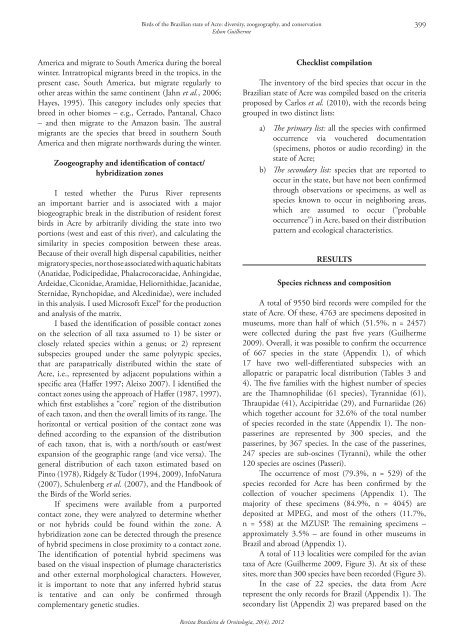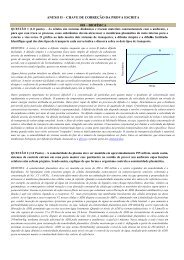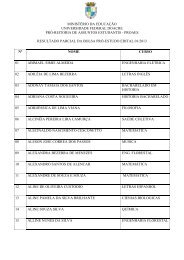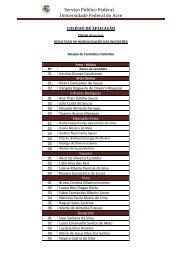Revista Brasileira de Ornitologia - Universidade Federal do Acre
Revista Brasileira de Ornitologia - Universidade Federal do Acre
Revista Brasileira de Ornitologia - Universidade Federal do Acre
You also want an ePaper? Increase the reach of your titles
YUMPU automatically turns print PDFs into web optimized ePapers that Google loves.
Birds of the Brazilian state of <strong>Acre</strong>: diversity, zoogeography, and conservationEdson Guilherme399America and migrate to South America during the borealwinter. Intratropical migrants breed in the tropics, in thepresent case, South America, but migrate regularly toother areas within the same continent (Jahn et al., 2006;Hayes, 1995). This category inclu<strong>de</strong>s only species thatbreed in other biomes – e.g., Cerra<strong>do</strong>, Pantanal, Chaco– and then migrate to the Amazon basin. The australmigrants are the species that breed in southern SouthAmerica and then migrate northwards during the winter.Zoogeography and i<strong>de</strong>ntification of contact/hybridization zonesI tested whether the Purus River representsan important barrier and is associated with a majorbiogeographic break in the distribution of resi<strong>de</strong>nt forestbirds in <strong>Acre</strong> by arbitrarily dividing the state into twoportions (west and east of this river), and calculating thesimilarity in species composition between these areas.Because of their overall high dispersal capabilities, neithermigratory species, nor those associated with aquatic habitats(Anatidae, Podicipedidae, Phalacrocoracidae, Anhingidae,Ar<strong>de</strong>idae, Ciconidae, Aramidae, Heliornithidae, Jacanidae,Sternidae, Rynchopidae, and Alcedinidae), were inclu<strong>de</strong>din this analysis. I used Microsoft Excel® for the productionand analysis of the matrix.I based the i<strong>de</strong>ntification of possible contact zoneson the selection of all taxa assumed to 1) be sister orclosely related species within a genus; or 2) representsubspecies grouped un<strong>de</strong>r the same polytypic species,that are parapatrically distributed within the state of<strong>Acre</strong>, i.e., represented by adjacent populations within aspecific area (Haffer 1997; Aleixo 2007). I i<strong>de</strong>ntified thecontact zones using the approach of Haffer (1987, 1997),which first establishes a “core” region of the distributionof each taxon, and then the overall limits of its range. Thehorizontal or vertical position of the contact zone was<strong>de</strong>fined according to the expansion of the distributionof each taxon, that is, with a north/south or east/westexpansion of the geographic range (and vice versa). Thegeneral distribution of each taxon estimated based onPinto (1978), Ridgely & Tu<strong>do</strong>r (1994, 2009), InfoNatura(2007), Schulenberg et al. (2007), and the Handbook ofthe Birds of the World series.If specimens were available from a purportedcontact zone, they were analyzed to <strong>de</strong>termine whetheror not hybrids could be found within the zone. Ahybridization zone can be <strong>de</strong>tected through the presenceof hybrid specimens in close proximity to a contact zone.The i<strong>de</strong>ntification of potential hybrid specimens wasbased on the visual inspection of plumage characteristicsand other external morphological characters. However,it is important to note that any inferred hybrid statusis tentative and can only be confirmed throughcomplementary genetic studies.Checklist compilationThe inventory of the bird species that occur in theBrazilian state of <strong>Acre</strong> was compiled based on the criteriaproposed by Carlos et al. (2010), with the records beinggrouped in two distinct lists:a) The primary list: all the species with confirme<strong>do</strong>ccurrence via vouchered <strong>do</strong>cumentation(specimens, photos or audio recording) in thestate of <strong>Acre</strong>;b) The secondary list: species that are reported tooccur in the state, but have not been confirmedthrough observations or specimens, as well asspecies known to occur in neighboring areas,which are assumed to occur (“probableoccurrence”) in <strong>Acre</strong>, based on their distributionpattern and ecological characteristics.RESULTSSpecies richness and compositionA total of 9550 bird records were compiled for thestate of <strong>Acre</strong>. Of these, 4763 are specimens <strong>de</strong>posited inmuseums, more than half of which (51.5%, n = 2457)were collected during the past five years (Guilherme2009). Overall, it was possible to confirm the occurrenceof 667 species in the state (Appendix 1), of which17 have two well-differentiated subspecies with anallopatric or parapatric local distribution (Tables 3 and4). The five families with the highest number of speciesare the Thamnophilidae (61 species), Tyrannidae (61),Thraupidae (41), Accipitridae (29), and Furnariidae (26)which together account for 32.6% of the total numberof species recor<strong>de</strong>d in the state (Appendix 1). The nonpasserinesare represented by 300 species, and thepasserines, by 367 species. In the case of the passerines,247 species are sub-oscines (Tyranni), while the other120 species are oscines (Passeri).The occurrence of most (79.3%, n = 529) of thespecies recor<strong>de</strong>d for <strong>Acre</strong> has been confirmed by thecollection of voucher specimens (Appendix 1). Themajority of these specimens (84.9%, n = 4045) are<strong>de</strong>posited at MPEG, and most of the others (11.7%,n = 558) at the MZUSP. The remaining specimens –approximately 3.5% – are found in other museums inBrazil and abroad (Appendix 1).A total of 113 localities were compiled for the aviantaxa of <strong>Acre</strong> (Guilherme 2009, Figure 3). At six of thesesites, more than 300 species have been recor<strong>de</strong>d (Figure 3).In the case of 22 species, the data from <strong>Acre</strong>represent the only records for Brazil (Appendix 1). Thesecondary list (Appendix 2) was prepared based on the<strong>Revista</strong> <strong>Brasileira</strong> <strong>de</strong> <strong>Ornitologia</strong>, 20(4), 2012










